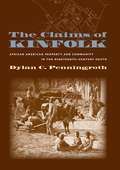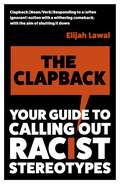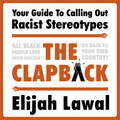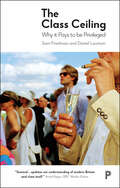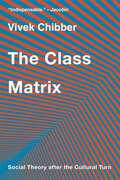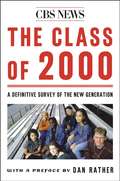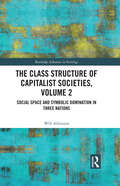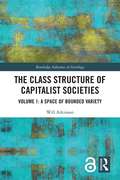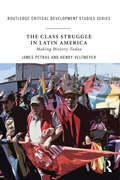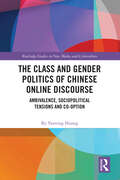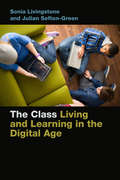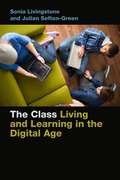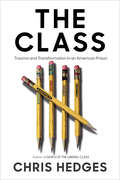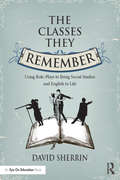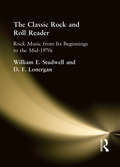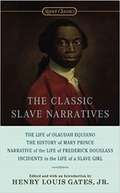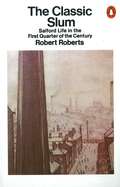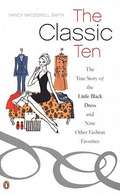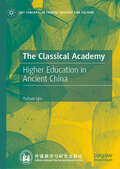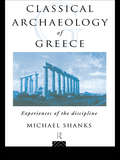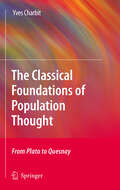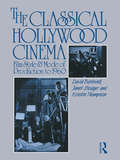- Table View
- List View
The Claims of Kinfolk
by Dylan C. PenningrothIn The Claims of Kinfolk, Dylan Penningroth uncovers an extensive informal economy of property ownership among slaves and sheds new light on African American family and community life from the heyday of plantation slavery to the "freedom generation" of the 1870s. By focusing on relationships among blacks, as well as on the more familiar struggles between the races, Penningroth exposes a dynamic process of community and family definition. He also includes a comparative analysis of slavery and slave property ownership along the Gold Coast in West Africa, revealing significant differences between the African and American contexts.Property ownership was widespread among slaves across the antebellum South, as slaves seized the small opportunities for ownership permitted by their masters. While there was no legal framework to protect or even recognize slaves' property rights, an informal system of acknowledgment recognized by both blacks and whites enabled slaves to mark the boundaries of possession. In turn, property ownership--and the negotiations it entailed--influenced and shaped kinship and community ties. Enriching common notions of slave life, Penningroth reveals how property ownership engendered conflict as well as solidarity within black families and communities. Moreover, he demonstrates that property had less to do with individual legal rights than with constantly negotiated, extralegal social ties.
The Clamorgans: One Family's History of Race in America
by Julie WinchThe Damning, Absurd, and Revelatory History of Race in America Told through the History of a Single FamilyHistorian Julie Winch uses her sweeping, multigenerational history of the unforgettable Clamorgans to chronicle how one family navigated race in America from the 1780s through the 1950s. What she discovers overturns decades of received academic wisdom. Far from an impermeable wall fixed by whites, race opened up a moral gray zone that enterprising blacks manipulated to whatever advantage they could obtain. The Clamorgan clan traces to the family patriarch Jacques Clamorgan, a French adventurer of questionable ethics who bought up, or at least claimed to have bought up, huge tracts of land around St. Louis. On his death, he bequeathed his holdings to his mixed-race, illegitimate heirs, setting off nearly two centuries of litigation. The result is a window on a remarkable family that by the early twentieth century variously claimed to be black, Creole, French, Spanish, Brazilian, Jewish, and white. The Clamorgans is a remarkable counterpoint to the central claim of whiteness studies, namely that race as a social construct was manipulated by whites to justify discrimination. Winch finds in the Clamorgans generations upon generations of men and women who studiously negotiated the very fluid notion of race to further their own interests. Winch's remarkable achievement is to capture in the vivid lives of this unforgettable family the degree to which race was open to manipulation by Americans on both sides of the racial divide.
The Clapback: Your Guide to Calling out Racist Stereotypes
by Elijah LawalClapback: [Noun / Verb] Responding to a (often ignorant) notion with a withering comeback; with the aim of shutting. it. down.___________In order to have an honest and open conversation about race, we need to identify areas where things are not right. The Clapback: Your Guide to Calling Out Racist Stereotypes examines the evolution of the negative stereotypes towards the black community and arms you with the tools to shut them down once and for all. Taking readers on a journey through history, and providing facts and detailed research, this is an eye-opening and refreshing look at race and language. With a light-hearted, razor sharp wit and a refreshing honesty, The Clapback is the handbook the world needs - dishing out the hard truths and providing a road map for bringing some 'act right' into our everyday lives.It's time to Clapback.
The Clapback: Your Guide to Calling out Racist Stereotypes
by Elijah LawalA definitive guide to calling out racial stereotypes and understanding the meaning behind them___________Clapback: [Noun / Verb] Responding to a (often ignorant) notion with a withering comeback; with the aim of shutting. it. down.___________In order to have an honest and open conversation about race, we need to identify areas where things are not right. The Clapback: How to Call Out Harmful Black Stereotypes examines the evolution of the negative stereotypes towards the black community and arms you with the tools to shut them down once and for all. Taking readers on a journey through history, and providing facts and detailed research, this is an eye-opening and refreshing look at race and language. With a light-hearted, razor sharp wit and a refreshing honesty, The Clapback is the handbook the world needs - dishing out the hard truths and providing a road map for bringing some 'act right' into our everyday lives.It's time to Clapback.(p)2019 Hodder & Stoughton Limited
The Class Ceiling: Why it Pays to be Privileged
by Sam Friedman Daniel LaurisonPoliticians continually tell us that anyone can get ahead. But is that really true? This important book takes readers behind the closed doors of elite employers to reveal how class affects who gets to the top. Friedman and Laurison show that a powerful ‘class pay gap’ exists in Britain’s elite occupations. Even when those from working-class backgrounds make it into prestigious jobs, they earn, on average, 16% less than colleagues from privileged backgrounds. But why is this the case? . Drawing on 200 interviews across four case studies - television, accountancy, architecture, and acting – they explore the complex barriers facing the upwardly mobile. This is a rich, ambitious book that demands we take seriously not just the glass but also the class ceiling.
The Class Matrix: Social Theory after the Cultural Turn
by Vivek ChibberAn influential sociologist revives materialist explanations of class, while accommodating the best of rival cultural theory. Following the collapse of the Soviet Union, analysis of class and other basic structures of capitalism was sidelined by theorists who argued that social and economic life is reducible to culture—that our choices reflect interpretations of the world around us rather than the limitations imposed by basic material facts. Today, capitalism is back on the agenda, as gross inequalities in wealth and power have pushed scholars to reopen materialist lines of inquiry. But it would be a mistake to pretend that the cultural turn never happened. Vivek Chibber instead engages cultural theory seriously, proposing a fusion of materialism and the most useful insights of its rival. Chibber shows that it is possible to accommodate the main arguments from the cultural turn within a robust materialist framework: one can agree that the making of meaning plays an important role in social agency, while still recognizing the fundamental power of class structure and class formation. Chibber vindicates classical materialism by demonstrating that it in fact accounts for phenomena cultural theorists thought it was powerless to explain. But he also shows that aspects of class are indeed centrally affected by cultural factors. The Class Matrix does not seek to displace culture from the analysis of modern capitalism. Rather, in prose of exemplary clarity, Chibber gives culture its due alongside what Marx called “the dull compulsion of economic relations.”
The Class Of 2000
by Dan Rather Cbs NewsIn 1996, in big cities and small towns across America, a new crop of teenagers entered the ninth grade. These students, the class of 2000, experienced the world in a unique way, often enjoying the benefits of a booming economy but also living through a wave of school violence, a presidential sex scandal and impeachment, the dawn of a new century, and the rise of the Internet. Since their first day of high school, the class of 2000 has been interviewed by CBS News in an unprecedented, in-depth study. CBS News's goal was to present a compelling portrait of our country's problems and promise as seen through the eyes of these students. To reach this end, the CBS News Polling Unit conducted scientific polls, revealing the thoughts, fears, and expectations of the class of 2000. The exclusive results of this study are rendered in the e-book The Class of 2000: A Definitive Survey of the New Generation. It paints an unusally clear picture of how these teenagers, now on the brink of adulthood, see the world and their place in it. The Class of 2000 is broken down into important topics such as lying and cheating, religion, dating and sexuality, drugs, guns and violence, school quality, and race relations. Each topic includes profiles and photos of some of the young people interviewed as well as the full polling results and an analysis.
The Class Structure of Capitalist Societies, Volume 2: Social Space and Symbolic Domination in Three Nations (Routledge Advances in Sociology)
by Will AtkinsonThe second volume of The Class Structure of Capitalist Societies maps the distribution of social powers and associated properties and lifestyles in unparalleled detail by examining the results of a brand-new survey delivered in Sweden, Germany and the US. Continuing the cross-national investigation of the shape and effects of class systems across capitalist nations, the analyses in Volume 2 are embedded in a novel sociological theory of international relations, sustained reflections on the relationship between national standing and class structure and extensive reconstruction of the histories of class in each of the three nations studied. The ultimate conclusion, however, is that not only that the fundamental structure of class today the same across the three cases, for all their unique cultural and historical features, but their translation into differences of taste, practice and symbolic violence, always cross-cut by gender, follow highly familiar patterns too. This volume will appeal to scholars and advanced undergraduate and postgraduate students interested in sociology, politics and demography and is essential reading for all those interested in social class across the globe.
The Class Structure of Capitalist Societies: Volume 1: A Space of Bounded Variety (Routledge Advances in Sociology)
by Will AtkinsonThis first volume of The Class Structure of Capitalist Societies offers a bold and wide-ranging assessment of the shape and effects of class systems across a diverse range of capitalist nations. Plumbing a trove of data and deploying cutting-edge techniques, it carefully maps the distribution of the key sources of power and documents the major convergences and divergences between market societies old and new. Establishing that the multidimensional vision of class proposed decades ago by Pierre Bourdieu appears to hold good throughout Europe, parts of the wider Western world and Eastern Asia, the book goes on to examine a number of significant themes: the relationship between class and occupation; the intersection of class with gender, religion, geography and age; the correspondences between social position and political attitudes; self-positioning in the class structure; and the extent of belief in meritocracy. For all the striking cross-national commonalities, however, the book unearths consistent variations seemingly linked to distinct politico-economic regimes. This title will appeal to scholars and advanced undergraduate and postgraduate students interested in sociology, politics and demography, and is essential reading for all those interested in social class across the globe.
The Class Struggle in Latin America: Making History Today (Routledge Critical Development Studies)
by Henry Veltmeyer James PetrasThe Class Struggle in Latin America: Making History Today analyses the political and economic dynamics of development in Latin America through the lens of class struggle. Focusing in particular on Peru, Paraguay, Chile, Colombia, Argentina, Brazil and Venezuela, the book identifies how the shifts and changing dynamics of the class struggle have impacted on the rise, demise and resurgence of neo-liberal regimes in Latin America. This innovative book offers a unique perspective on the evolving dynamics of class struggle, engaging both the destructive forces of capitalist development and those seeking to consolidate the system and preserve the status quo, alongside the efforts of popular resistance concerned with the destructive ravages of capitalism on humankind, society and the global environment. Using theoretical observations based on empirical and historical case studies, this book argues that the class struggle remains intrinsically linked to the march of capitalist development. At a time when post-neo-liberal regimes in Latin America are faltering, this supplementary text provides a guide to the economic and political dynamics of capitalist development in the region, which will be invaluable to students and researchers of international development, anthropology and sociology, as well as those with an interest in Latin American politics and development.
The Class and Gender Politics of Chinese Online Discourse: Ambivalence, Sociopolitical Tensions and Co-option (Routledge Studies in New Media and Cyberculture)
by Yanning HuangThis book offers an in- depth study of the quasi- political, self-deprecating, and parodic buzzwords and memes prevalent in Chinese online discourse.Combining discourse analysis with in- depth audience research among the young internet users who deploy these buzzwords in on- and offline contexts, the book explores the historical and social implications of online wordplay for sustaining or challenging the contemporary social order in China. Yanning Huang adopts a combination of media and communications, social anthropology, and socio- linguistic perspectives to shed light on various forms of agency enacted by different social groups in their embracing, negotiation of, or disengagement from online buzzwords, before addressing how the discourses of online wordplay have been co-opted by corporations and party-media.Offering a rigorous and panoramic analysis of the politics and logics of online wordplay in contemporary China, and providing a critical and nuanced analytical framework for studying digital culture and participation in China and elsewhere, this book will be an important resource for scholars and students of media and communication studies, Internet and digital media studies, discourse analysis, Asian studies, and social anthropology.
The Class: A Memoir of a Place, a Time, and Us
by Ken DrydenINSTANT NATIONAL BESTSELLER • Shortlisted for the 2024 Speaker&’s Book AwardFrom bestselling author Ken Dryden, a riveting new book.On Tuesday, September 6, 1960, the day after Labour Day, class 9G at Etobicoke Collegiate Institute in a suburb of Toronto assembled for the first time. Its thirty-five students, having written special exams, came to be known as the &“Selected Class.&”They would stay together through high school, with few exceptions. They would spend more than two hundred days a year together. Few had known each other before. Few have been in other than accidental contact in all the decades since.Their ancestors were almost all from working-class backgrounds. Their parents had lived their formative years through depression and war. They themselves were born into a postwar world of new homes, new schools, new churches. New suburbs. Of new classes like this one. Of boundless possibilities.When almost anything seems within reach, what do we reach for?Ken Dryden was one of these thirty-five. In his varied, improbable life, he had wondered often how he had gotten from there to here. How any of us do. He decided to try and find his classmates, to see how they are, what they are doing, how life has been for them. They talked many long hours, in a way they had never talked before. Most had married, some divorced, most have kids, many have grandkids.This is the story of a place, a time, and so much more.
The Class: Living and Learning in the Digital Age (Connected Youth and Digital Futures #1)
by Julian Sefton-Green Sonia LivingstoneAn intimate look at how children network, identify, learn and grow in a connected world.Read Online at connectedyouth.nyupress.orgDo today’s youth have more opportunities than their parents? As they build their own social and digital networks, does that offer new routes to learning and friendship? How do they navigate the meaning of education in a digitally connected but fiercely competitive, highly individualized world?Based upon fieldwork at an ordinary London school, The Class examines young people's experiences of growing up and learning in a digital world. In this original and engaging study, Livingstone and Sefton-Green explore youth values, teenagers’ perspectives on their futures, and their tactics for facing the opportunities and challenges that lie ahead. The authors follow the students as they move across their different social worlds—in school, at home, and with their friends, engaging in a range of activities from video games to drama clubs and music lessons. By portraying the texture of the students’ everyday lives, The Class seeks to understand how the structures of social class and cultural capital shape the development of personal interests, relationships and autonomy. Providing insights into how young people’s social, digital, and learning networks enable or disempower them, Livingstone and Sefton-Green reveal that the experience of disconnections and blocked pathways is often more common than that of connections and new opportunities.
The Class: Living and Learning in the Digital Age (Connected Youth and Digital Futures #1)
by Sonia Livingstone Julian Sefton-GreenAn intimate look at how children network, identify, learn and grow in a connected world.Read Online at connectedyouth.nyupress.orgDo today’s youth have more opportunities than their parents? As they build their own social and digital networks, does that offer new routes to learning and friendship? How do they navigate the meaning of education in a digitally connected but fiercely competitive, highly individualized world?Based upon fieldwork at an ordinary London school, The Class examines young people's experiences of growing up and learning in a digital world. In this original and engaging study, Livingstone and Sefton-Green explore youth values, teenagers’ perspectives on their futures, and their tactics for facing the opportunities and challenges that lie ahead. The authors follow the students as they move across their different social worlds—in school, at home, and with their friends, engaging in a range of activities from video games to drama clubs and music lessons. By portraying the texture of the students’ everyday lives, The Class seeks to understand how the structures of social class and cultural capital shape the development of personal interests, relationships and autonomy. Providing insights into how young people’s social, digital, and learning networks enable or disempower them, Livingstone and Sefton-Green reveal that the experience of disconnections and blocked pathways is often more common than that of connections and new opportunities.
The Class: Trauma and Transformation in an American Prison
by Chris Hedges"This book could change everything. It could change our minds. It could buttress our hearts. It could make graspable why today&’s prisons are contemporary slave plantations. I couldn&’t put it down and I tried." —Alice Walker, author of The Color PurpleA haunting and powerfully moving book that gives voice to the poorest among us and lays bare the cruelty of a penal system that too often defines their lives.In this unforgettable work, Pulitzer Prize-winning journalist Chris Hedges, who brought us War Is a Force That Gives Us Meaning and America, The Farewell Tour, provides an intimate and moving look at the lives of the students he teaches in a maximum-security prison. He and twenty-eight students (who together are serving a combined sentence of 515 years) read and discussed plays by Amiri Baraka, John Herbert, Tarell Alvin McCraney, Miguel Piñero and August Wilson, among others. Together they set out to write an original play drawing on their experiences of poverty, institutionalized racism, police brutality and mass incarceration. (Their play, Caged, would eventually perform to sold-out audiences and be published as a book in 2020.) In The Class, the men—some of whom know they will die in prison—give voice to the struggles of grief, shame, injustice, guilt and generational trauma they and their families have endured, as well as to their hopes and dreams. Hedges chronicles with heart-breaking intimacy the emotional struggle for artistic expression that leads to self-awareness, transformation and redemption. The Class is at once a story of creative triumph and a scorching critique of the racialized poverty that plagues North America and what it does to the most vulnerable.
The Classes They Remember: Using Role-plays And Mock Trials To Bring Social Studies And English To Life
by David SherrinLearn how to use role-plays to bring history and literature to life! When students take on the roles of historical or literary figures, they develop a greater understanding of characters’ identities and motivations, and are able to more deeply explore and reflect upon key issues and themes. In this new book from award-winning teacher David Sherrin, you’ll find out how this lively instructional format will make teaching a more immersive, interactive, and memorable experience for your middle school and high school students. The book includes: <P><P> A clear how-to guide to get the most out of role-playing in your class; Ready-made units and lessons to get you started right away, complete with sample scripts, scaffolding worksheets, and assessment rubrics; Templates and step-by-step instructions to help you design your own role-plays. <P><P> The pre-made units, which Sherrin spent years refining in his classroom, cover historical topics such as the rise of Nazi Germany and the Spanish conquest of the Aztecs. You’ll also find fun and interactive role-plays based on literary works like The Pearl and Fences. These lessons will help students at all ability levels to become better communicators, problem-solvers, and creative thinkers.
The Classic Rock and Roll Reader: Rock Music from Its Beginnings to the Mid-1970s
by William E Studwell David LonerganThe Classic Rock and Roll Reader: Rock Music from Its Beginnings to the Mid-1970s is chock full of entertaining essays to inform and delight you about an era that shaped our culture and future musical trends. This unique book will surprise and enchant even the most zealous music buff with facts and information on the songs that reflected America’s spirit and captured a nation&’s attention. The Classic Rock and Roll Reader is offbeat, somewhat irreverent, ironic, and ancedotal as it discusses hundreds of rock and non-rock compositions included in rock history era. The songs offer you information on: Rock’s Not So Dull Predecessors (for example, “Bewitched, Bothered, and Bewildered” and “The Cry of the Wild Goose”) The Pioneering Rock Songs (such as “Rock Around the Clock” and “Shake, Rattle, and Roll” ) Older Style Songs Amidst the Rocks (for example, “I Could Have Danced All Night” and “Rocky Mountain High” ) The Megastars and Megagroups (such as “Blue Suede Shoes,” “Respect,” and “Surfin’USA” ) The Best Songs that Never Made No. 1 (for example,“ I Feel Good” and “ Tie a Yellow Ribbon Round the Ole Oak Tree” )The Classic Rock and Roll Reader: Rock Music from Its Beginnings to the Mid-1970s also examines the music which preceded early rock, the music which followed early rock, and the numerous non-rock songs which flourished during the classic rock period. A wide spectrum of music is discussed in well over 100 essays on various songs. Musicians, librarians, and the general audience will be taken back to the birth of rock and roll and the various contributing influences. Analyzing each song’s place in rock history and giving some background about the artists, The Classic Rock and Roll Reader offers even the most avid music enthusiast new and unique information in this thorough and interesting guide.
The Classic Slave Narratives
by Henry Louis GatesNo group of slaves anywhere, in any era, has left such prolific testimony to the horror of bondage as African-American slaves. Here are four of the most notable narratives: The Life of Olaudah Equiano; The History of Mary Prince; Narrative of the Life of Frederick Douglass; and Incidents in the Life of Slave Girl.
The Classic Slum: Salford Life in the First Quarter of the Century
by Robert RobertsA study which combines personal reminiscences with careful historical research, the myth of the 'good old days' is summarily dispensed with; Robert Roberts describes the period of his childhood, when the main affect of poverty in Edwardian Salford was degredation, and, despite great resources of human courage, few could escape such a prison.
The Classic Ten
by Nancy Macdonell SmithNancy MacDonell Smith explores the origins, meaning, and remarkable staying power of the ten staples of feminine fashion: * the little black dress * the white shirt * the cashmere sweater * blue jeans * the suit * high heels * pearls * lipstick * sneakers * the trench coat Tracing the evolution of each item from inception to icon status, she reveals the history and social significance of each, from the black dress's associations with danger and death to the status implications of the classic white shirt. Incorporating sources from history, literature, magazines, and cinema, as well as her own witty anecdotes, Smith has created an engaging, informative guide to modern style. .
The Classical Academy: Higher Education in Ancient China (Key Concepts in Chinese Thought and Culture)
by Yuhua LyuThis book is one of the first to give a systematic account of shuyuan in English. Shuyuan (Classical Academies), as a type of higher education institution in ancient China, were closely related to the philosophical thoughts, social atmosphere, and humanistic cultivation in those times when they were prevalent, thus proving to be a worthy subject of study. This book collects and sorts out relevant historical materials, so as to explore the social environment where shuyuan were established, introduces a group of ancient scholars with strong personalities, reexamine their cultural heritage, and builds a bridge connecting modern and ancient thoughts.
The Classical Archaeology of Greece: Experiences of the Discipline (The\experience Of Archaeology Ser.)
by Michael ShanksArchaeologists do not discover the past but take the fragmentary remains which they recover and make something of them. Archaeology is a process of detection and supposition; this is what makes it so fascinating. However, the interpretations of archaeologists differ and change over time. They depend upon the amount of evidence available, the ideas and preconceptions of the archaeologist and their interests and aims.Michael Shanks's enlivening work is a guide to the discipline of classical archaeology and its objects. It assesses archaeology as a means of reconstructing ancient Greek society using the latest approaches of social archaeology. In addition, The Classical Archaeology of Greece outlines the history of the discipline and discusses why Classical Greece continues to fascinate us and why it has had such an impact on European civilization and identity.
The Classical Foundations of Population Thought
by Yves CharbitWhereas the history of demography as a social science has been amply explored, that of the construction of the concept of population has been neglected. Specialists systematically ignore a noteworthy paradox: strictly speaking, the great intellectual figures of the past dealt with in this book have not produced demographic theories or doctrines as such, but they have certainly given some thought to population at both levels. First, the central epistemological and methodological orientation of the book is presented. Ideas on population, far from being part of the harmonious advancement of knowledge are the product of their context, that is evidently demographic, but also economic, political and above all intellectual. Then the ideas on population of Plato, Bodin, the French mercantilists, Quesnay and the physiocrats are examined under this light. The last chapter addresses the implicit philosophical, economic and political issues of population thought.
The Classical Hollywood Cinema: Film Style and Mode of Production to 1960
by David Bordwell Kristin Thompson Janet StaigerHow films are conceived,planned, and produced leaves a mark upon the films, directly and structurally. The relations between film style and mode of production are, according to the authors, reciprocal and mutually influencing. The authors trace such topics as style, economics, and technology over time, demonstrating how significant changes occurred in Hollywood from the earliest days through the sixties.
The Classical Hollywood Cinema: Film Style and Mode of Production to 1960
by David Bordwell Kristin Thompson Janet Staiger'A dense, challenging and important book.' Philip French Observer 'At the very least, this blockbuster is probably the best single volume history of Hollywood we're likely to get for a very long time.' Paul Kerr City Limits 'Persuasively argued, the book is also packed with facts, figures and photographs.' Nigel Andrews Financial Times Acclaimed for their breakthrough approach, Bordwell, Staiger and Thompson analyze the basic conditions of American film-making as a historical institution and consider to what extent Hollywood film production constitutes a systematic enterprise, in both its style and its business operations. Despite differences of director, genre or studio, most Hollywood films operate within a set of shared assumptions about how a film should look and sound. Such assumptions are neither natural nor inevitable; but because classical-style films have been the type most widely seen, they have come to be accepted as the 'norm' of film-making and viewing. The authors show how these classical conventions were formulated and standardized, and how they responded to the arrival of sound, colour, widescreen ratios and stereophonic sound. They argue that each new technological development has served a function within an existing narrational system. The authors also examine how the Hollywood cinema standardized the film-making process itself. They describe how, over the course of its history, Hollywood developed distinct modes of production in a constant search for maximum efficiency, predictability and novelty. Set apart by its combination of theoretical analysis and empirical evidence, this book is the standard work on the classical Hollywood cinema style of film-making from the silent era to the 1960s. Now available in paperback, it is a 'must' for film students, lecturers and all those seriously interested in the development of the film industry.
